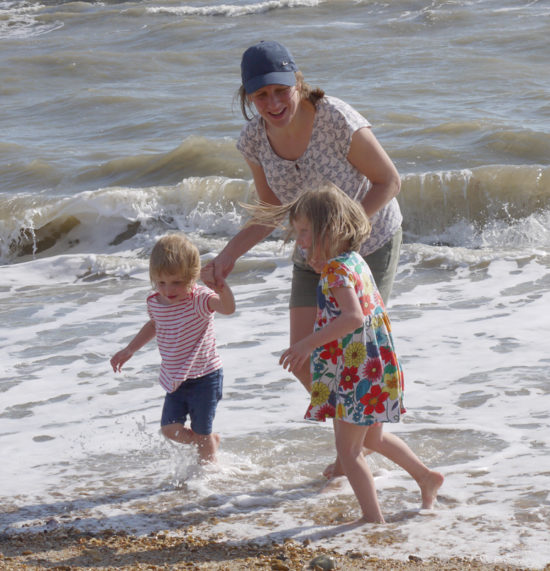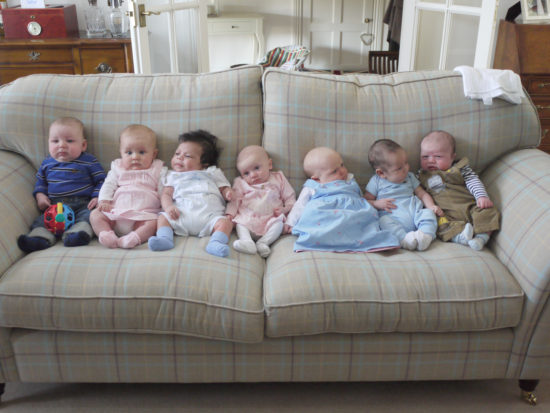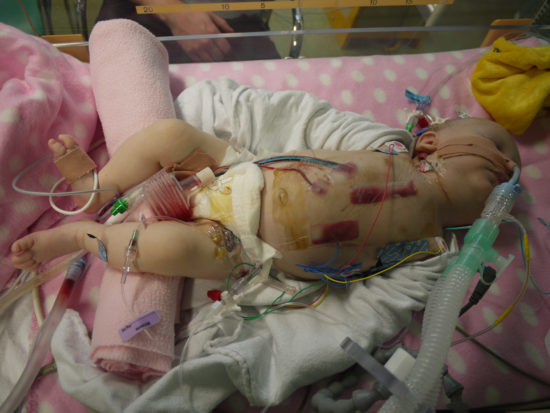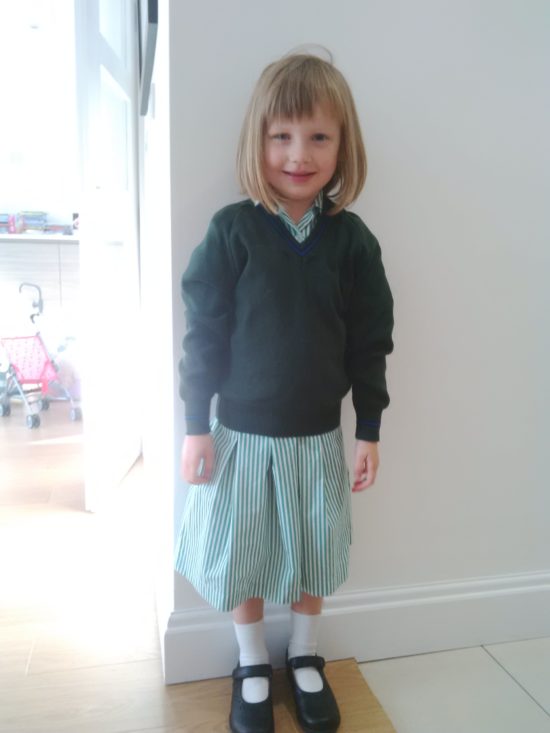Ingrid Marson, an NCT member from Welwyn and Hatfield branch, tells us about her daughter’s congenital heart condition and what signs parents should be aware of when it comes to their baby and potential heart defects.

I had a straightforward pregnancy and gave birth to Charlotte in our local midwife-led unit. She was fine at birth and passed her newborn health check.
She wouldn’t breastfeed after the birth, but the midwives said this was common and discharged us. When I got home, breastfeeding remained a challenge, with Charlotte (pictured in the middle of the row) not latching on properly and falling asleep during feeds. Her weight became a concern.

While most babies gain 5-7 ounces a week, she gained no more than an ounce each week and by eight weeks had fallen from the 50th percentile at birth to the 2nd percentile on growth charts.
After a few weeks we switched to mixed feeding, but even with formula, she wasn’t gaining weight and often fell asleep during bottle feeds. Looking back, she was less active and slept more than other babies. These should have been warning signs to us but as she was our first baby we knew no different. Health visitors reassured us that the poor weight gain was “simply a feeding issue”.
At Charlotte’s six week check, our GP picked up a ‘mild heart murmur’ and we were given a routine referral for a heart scan. My husband Ian and I used his work’s private health insurance to get an appointment sooner with a cardiologist at the Evelina London Children’s Hospital.
Ian and I sat in silence while the doctor scanned Charlotte’s heart. After a few minutes, we could tell the atmosphere was different to the antenatal scans. Then the news came – Charlotte had a serious congenital heart defect and needed open heart surgery urgently.
We wondered if she would lead a normal life.
Her heart condition, known as a coarctation, can deteriorate suddenly with a baby collapsing and suffering multiple organ failure. Charlotte also had large holes in her heart, and an abnormal heart valve, which made surgery more complex.
She was admitted immediately to the High Dependency Unit for round-the-clock monitoring.
Our world fell apart with the diagnosis. We went from being normal parents, worrying about sleep, nappies and feeding, to wondering whether she would survive the major surgery that lay ahead. We also wondered if she would ever lead a normal life.
Three days later, at just nine weeks old, we bathed Charlotte, dressed her in her hospital gown and handed her over to the anaesthetist. It was the toughest moment of our lives.

The surgical team would open her chest, stop her heart, and repair the defects.
After an impossible six hour wait, the phone call came. The surgery had been a success and Charlotte was stable in the Intensive Care Unit (pictured).
After eight more days in hospital and a couple of bumps along the way, Charlotte was discharged. We left hospital in time for Easter, and we will forever be thankful for the fantastic care we received at the Evelina Children’s Hospital.
Over the subsequent weeks and months, we slowly came to terms with Charlotte’s diagnosis. After each positive check-up, we grew in confidence that she may be able to have a normal life after all.

Charlotte is now nearly five years old and is a happy, energetic and confident schoolgirl (pictured on her first day of school). She is also a loving big sister to Alice, who has a healthy heart.
Except for a faint line on Charlotte’s chest, you would never guess that she had been through major surgery. She still has regular check-ups and may need more surgery in the future – it all depends on how her heart grows.
After Charlotte’s diagnosis, I spoke to one of the midwives who discharged us about what happened. Feeding in the early days can be challenging so a feeding issue by itself might not be a warning sign of anything else. However, in rare cases – around 1 in 145 babies born in the UK has a congenital heart defect – it can be a sign of a life-threatening heart problem. I believe it’s vital that all parents are familiar with the symptoms of heart defects.
To help parents understand the signs and symptoms of congenital heart defects, the charity Tiny Tickers has produced this useful Think HEART chart:
H = Heart rate: Is your baby’s heart rate too fast or too slow? It should normally be 100-160 beats per minute.
E = Energy: Is your baby sleepy, quiet or floppy? Are they too tired to feed, or falling asleep during feeds?
A = Appearance: Is your baby a pale, waxy, dusky, blue, purple, mottled or grey colour?
R = Respiration: Is your baby breathing too fast or too slowly? It should normally be 40-60 breaths per minute.
T = Temperature: Is your baby persistently cold to touch – particularly their hands and feet?
If you’re worried about your child, talk to your midwife, health visitor or GP. If you can’t see them straight away, try your local walk-in centre or accident and emergency department or call NHS 111.
If you’re pregnant, the 20 week scan is the best opportunity to detect any heart defects before your baby is born. Find out about the Tiny Tickers’ Big Tick campaign.